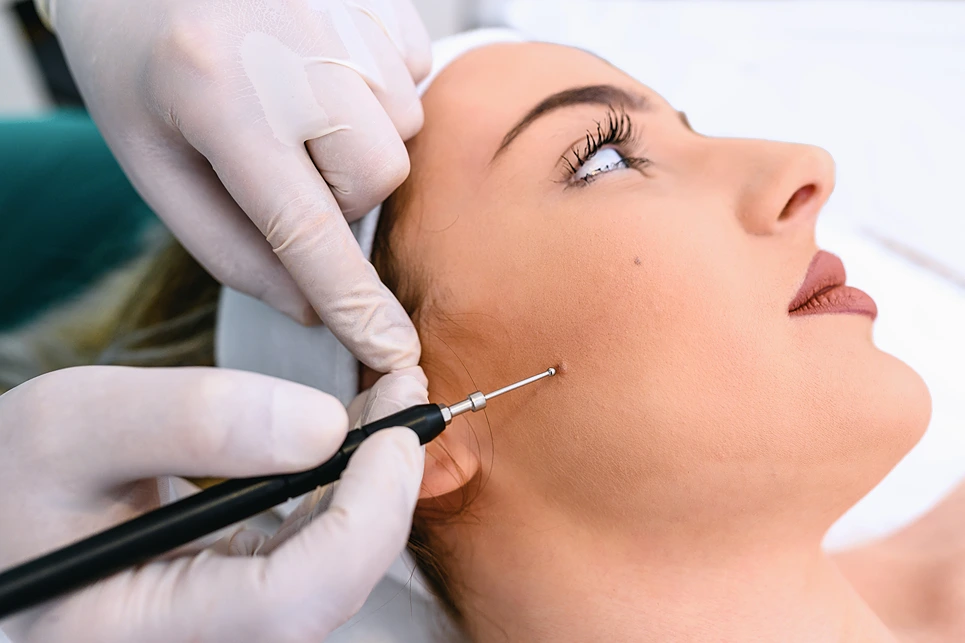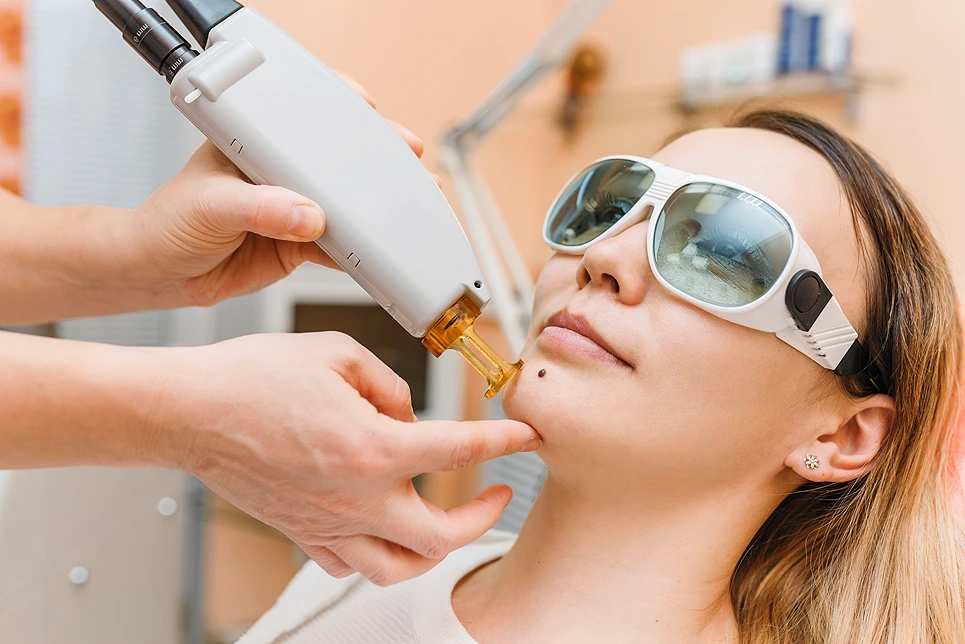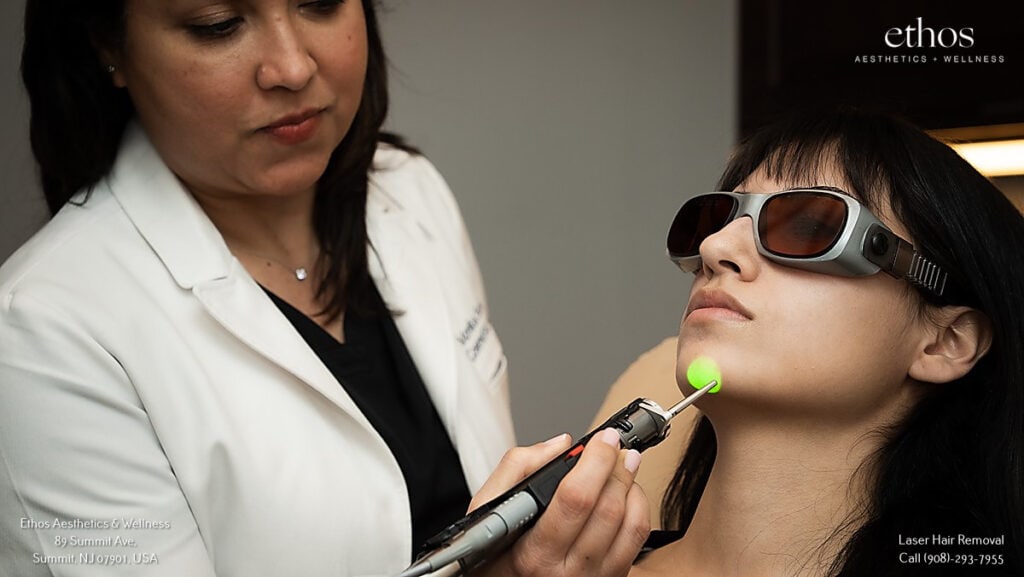Everything You Need To Know Before Getting Treatment
You’ve decided to get laser hair removal to permanently banish unwanted hair. But you notice you have moles in the treatment areas. Is it safe to get laser hair removal over moles? What precautions should you take?
At Ethos Aesthetics + Wellness, we recognize your concerns. With Dr. Soni’s expertise, we want to empower you to make informed decisions about laser hair removal and moles. This ultimate guide covers everything you need to know before your treatment.
Get the facts and peace of mind about laser hair removal and moles. Schedule a consultation with Dr. Soni to discuss your treatment plan today.
Should Laser Hair Removal Be Used Over Moles?

Laser hair removal relies on targeting melanin, the pigment that gives hair and moles their color. So it stands to reason that lasers can potentially affect moles.
Lasers should not be used directly on top of existing moles as they can damage the extra melanin in moles, leading to:
- Changes in color – moles may turn darker with hyperpigmentation
- Alterations in size and shape
- Blistering, scabbing, scarring
- Increased risk of complications or skin cancer
Lasers can be safely used around moles to remove hair in those areas. But technicians should avoid directing the laser light directly at moles themselves. Protective covering over moles is recommended.
Don’t Risk Mole Damage. Book a Consultation for Laser Hair Removal with Dr. Soni for a Safe, Hair-Free Experience
What If Mole Changes Color After Laser Hair Removal?
It’s common for moles to temporarily change color and appear darker after laser treatment. The laser affects the pigmented cells, causing the mole to become hyperpigmented.
In most cases, the darkening is temporary. The mole will typically return to its normal color in 4-8 weeks as it heals.
However, if the mole remains significantly darker or has changed shape months later, it’s best to get it examined. Schedule an appointment with Dr. Soni or a dermatologist. They can determine if the mole needs monitoring, biopsy, or removal after being altered by laser exposure.
Catching any potentially abnormal changes early is recommended. Don’t hesitate to get moles checked out after laser treatment in the area.
Can Laser Hair Removal Cause New Moles to Form?
There is no evidence that laser hair removal causes new moles to develop where there were none before. The treatment eliminates hair follicles but does not create new pigmented skin growths.
Darkening, scaling, and contour changes may make a mole more noticeable or be mistaken for a new mole. It’s vital to monitor your skin closely after each laser session.
Record any moles that seem “new” or altered. Have Dr. Soni examine any moles causing concern. Timely biopsies can detect problems early.
Risks of Laser Hair Removal on Moles

Research has shown laser exposure can potentially cause adverse changes to moles:
- According to the Australian Cancer Council, atypical moles may develop altered appearance after laser hair removal. These irregular moles need careful monitoring to watch for signs of melanoma.
- Laser treatment can damage pigment-producing cells inside moles. This disruption can lead to scarring, blistering, and discoloration.
- If moles exhibit permanent darkening or changing contours after laser exposure, biopsy may be required to test for skin cancer.
- Accidental direct laser exposure can burn or blister moles, increasing risks of infection and scarring.
- Patients with dysplastic nevi syndrome or numerous atypical moles require special percussion before undergoing laser hair removal. The treatment could worsen the appearance of abnormal moles.
The risks involved emphasize the importance of mole mapping before starting laser hair removal. Technicians should photograph and document all moles in treatment areas. Protective coverings prevent direct laser exposure.
What If a Mole Got Burned During Laser Treatment?
Accidentally burning a mole with the laser is possible but can usually be avoided with proper precautions. However, in the event that it does occur, here are some important steps to take:
- Monitor the mole in the days and weeks after the laser burn. Look for any changes in color, size, shape, or symptoms like pain, itching, oozing, or bleeding. Compare the appearance to how it looked before being burned. Even subtle changes could be a sign of damage.
- Practice diligent sun protection in the area using broad spectrum sunscreen and protective clothing. Laser burns can increase the skin’s sensitivity to UV radiation and further damage.
- Schedule an appointment to have the mole evaluated by Dr. Soni or your dermatologist as soon as possible. They may want to perform a biopsy or excision of the mole to check for cancerous changes triggered by the burn. Early detection is key for the best outcomes.
- Avoid any additional laser exposure to the mole until it has had time to completely heal, which could take weeks. More laser treatment could worsen the damage and provoke changes.
- Try not to panic. One small laser burn alone likely does not drastically increase the risk of melanoma. But monitoring for changes and protection from further UV exposure are wise precautions. Contact your doctor promptly about any unusual or worsening mole changes.
- Avoid laser procedures altogether if you have numerous atypical moles that would be difficult to avoid. The risks may outweigh the benefits in those cases. Discuss your options with Dr. Soni.
Had a Laser Burn Incident? Contact Us for Immediate Guidance and Minimize Potential Complications
How Can I Cover Up Moles During Laser Hair Removal?
Before your laser treatment, the technician should document and photograph any moles in the regions to be lasered. They will cover moles with opaque protective materials.
Common methods to conceal moles for laser hair removal include:
| Method | Description |
| Medical tape or bandages | These fully block laser light from reaching moles. Multiple layers are applied for larger moles. |
| White colored pencil or concealer | The white pigment deflects the laser beam away from the mole. Must be reapplied between passes. |
| Cold gel packs or wet gauze | These cooling elements protect skin from laser penetration and heat. Provides additional coverage over moles. |
| Avoid reflective or metallic coverings | Those could potentially redirect laser energy into the mole and cause burns. Stick to opaque protection. |
Let the technician know of any concerns about moles before your treatment. They will take steps to prevent direct laser exposure.
Is Laser Hair Removal Risky Around Birthmarks?
Birthmarks create some of the same concerns as moles when undergoing laser:
- Laser can potentially cause discoloration of birthmarks since it targets melanin pigment.
- Visible changes make monitoring birthmarks for skin cancer signs more difficult.
- Those with café au lait spots or congenital nevi require special evaluation before laser hair removal. High risk of birthmark alterations.
- Avoid directing lasers directly on top of birthmarks. But hair around them can still be removed.
- Not all birthmarks carry increased risk. Consult Dr. Soni about your specific types of birthmarks and optimal precautions.
With proper protective steps, laser remains an option to eliminate unwanted hair growth around most birthmarks.
Can Laser Hair Removal Cause More Freckles to Appear?
There is no scientific proof that laser hair removal causes more freckles or dark spots to appear. The laser light is selectively absorbed by hair melanin, not the melanin in freckles.
However, freckles may seemingly increase after laser treatment because:
- New sun spots can develop if you fail to protect skin from UV light after sessions. Always wear sunscreen.
- Lasers can make existing freckles and lentigines darker temporarily after exposure. But this hyperpigmentation fades.
- Hormonal changes like pregnancy or birth control can lead to new freckling unrelated to the laser treatment itself.
Freckle Worries? Let Dr. Soni Address Your Concerns and Provide Expert Guidance
The Bottom Line

Laser hair removal is a safe, effective method for permanent hair reduction in most cases. But special care must be taken around existing moles and marks to prevent complications.
Now you know the facts about laser hair removal and moles. You understand the right precautions to take and what to watch for after treatment.
At Ethos Aesthetics + Wellness, your satisfaction and safety are our top concerns. Schedule a consultation with Dr. Soni to discuss your laser hair removal questions confidently. Discover how our customized treatments can help you achieve smooth, stubble-free skin.







